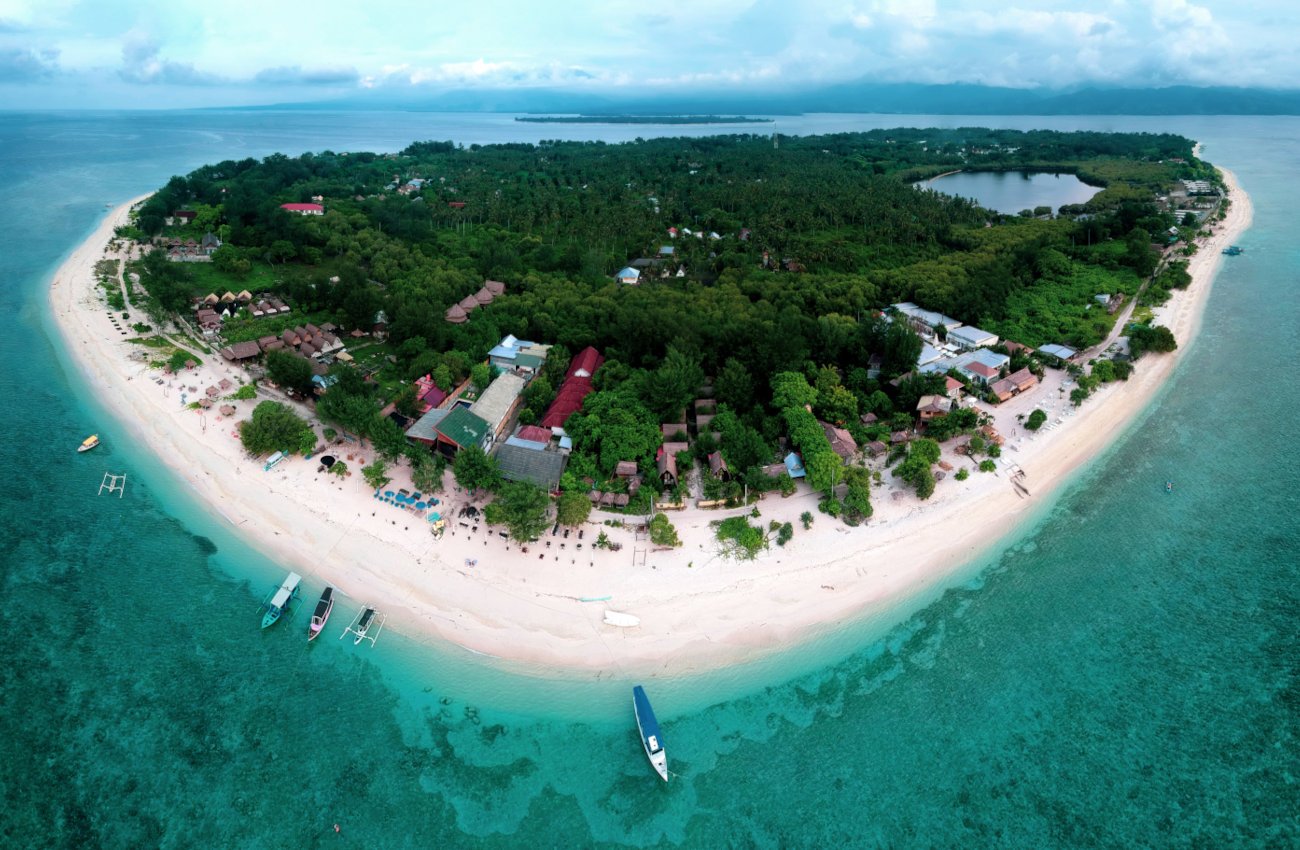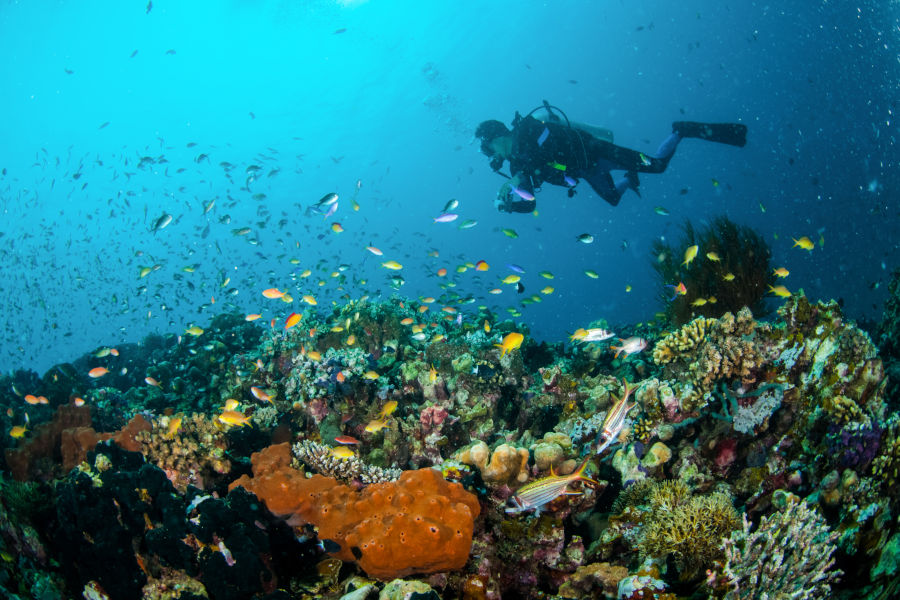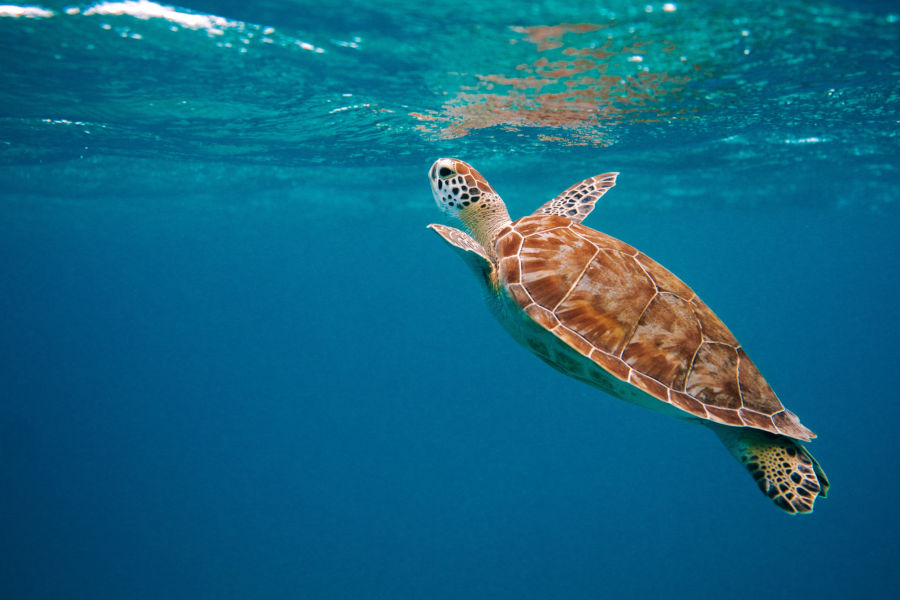Gili Meno – the central Gili. It is also the smallest and most quiet of the three. Imagine the Gili Islands 10 to 20 years ago before they became one of the most popular tourist destinations in Indonesia. This is what you’ll find in Gili Meno. At some spots on the islands you’ll feel like holidaying on a private island. Other places are busier and you’ll discovery a chilled-out beach life and the opportunities to mingle with other travellers. Meno isn’t quiet for its lack of beauty because it is arguably the prettiest of the three. Meno’s beaches rank in the Top 10 of Indonesia’s best beaches with enchanting white sand that continues into the clear waters that surround the island. You can’t really go wrong in choosing your place to stay based on the best beach in front of your door because frankly speaking, they are all quite stunning.
Gili Meno has less accommodations available than Gili Air or Gili Trawangan but still plenty to choose from. Divine Divers has a pool but a lot of the accommodation options don’t, so keep that in mind when booking. The central part of the islands hosts some hostels for travelers on a budget but the most common type of accommodation you’ll find are basic bungalows and homestays. Those are also mainly located in central Meno. On the beaches you’ll also find upper class or even luxury hotels such as Mahamaya or the Bask which is scheduled to open in July 2022.
You will find no motorized transport on Gili Meno same as on Gili Air and Gili Trawangan. You’ll get to enjoy unknown silence with cicadas chirping rather than honking motorbikes and good air quality. If you don’t feel like walking, you can always rent a bike or have a cidomo (horse card) drop your luggage at your hotel.
There aren’t loads of restaurants on Gili Meno, but a number of really nice seafood places and small family-run warungs to choose from. Some warungs are centered around the harbour area, but there are some lovely eateries on Sunset beach as well (our beach!). Some of the best warungs can be found deeper in the center of the island.
Gili Meno is one of the few places in the Bali-Lombok region where you can truly feel remote and away from mass tourism. No matter if you are planning a day trip or spend a few nights it will be a unique and worthwhile visit. If you have no idea what to do with your time on Gili Meno, please find our (totally biased) guide with the best things to do on the island:
1. Diving
The three small Gili Islands on the north west coast of Lombok are popular with scuba divers from all over the globe.They are also one of the best places in this world to learn how to dive or take advanced diving lessons. These are the reasons why:
Variety of dive sites – 20 different dive sites with a great variety of marine life from big stuff to macro, it’s all here. But not only that, the topography of the various sites is interesting and you’ll get to dive on sloping reefs, pinnacles, wrecks, drop offs and the biorocks, a famous artificial reef project.
Dive conditions – you’ll find warm water and great visibility all year round. In December and January the water might not be as clear as during the rest of the year but we are still talking about 15 meters viz. This is still better than in many other places on a good day.
Location of the dive sites – a diver’s heaven! The Gili dive sites are very close by and easily accessible. Especially Gili Meno with its central location has very easy access to all dive sites around the Gili Islands. Other dive centers have a 10-to-15-minute boat ride to reach the great sites on the west coast of Meno. It only takes Divine Divers 2 minutes. We are often the first ones to jump in the water and don’t have to share the dive sites with other divers.
Suitable for all diving levels – beginners to dive pros will find challenges. Whether you’d like to learn how to dive or do an introduction to tech diving it is all here on the Gili Islands. On the Gilis you’ll have the prime chance to learn to dive with almost no weights since you won’t have to wear a (thick) wetsuit. You’ll become a better diver by practicing buoyancy with your breath rather than you BCD.
2. Snorkeling
You can dive, freedive or snorkel to enjoy the magic of the underwater world of the Gili Islands. Not saying one is better than the other, we think it is best to combine. While you’ll get a top-down view when snorkeling, you can be really close to corals and fish while diving. Some of the best-known snorkel spots around the Gilis are located off Meno. This makes Meno without question the best island for snorkelers. It offers easy access to all those amazing underwater sights such as Turtle Point, the Bounty Wreck and probably the most photographed spot in Indonesia – the Meno underwater statues.
Every day dozens of boats bring snorkelers to these beautiful places on multi-stop snorkel tours. To explore them from Meno, you can either book a tour with an agent or directly with the operator, charter a private boat or simply walk into the sea with your own or rented snorkel gear. Please be careful to not step on corals on the reef top. If the tide is too low it is better to wait for high tide to avoid damage on the fragile marine life that surrounds the beautiful island paradise.
- Turtle Point is located off the north east coast of Gili Meno. You’ll best recognize the snorkel spots by the tour boats that stop there. If you’d like to approach from the shore, simply swim towards the boats. Within minutes you’ll probably see your first turtle. On a good day, this won’t be the only turtle you’ll see. If you stick to simple rules, you’ll get a lot of time with those magnificent creatures because they don’t tend to be scared of people. Watch and don’t touch is the most important one of those general guidelines. Even if it might be tempting, refrain yourself from taking a selfie and keep a distance of two meters.
- Further to the west and conveniently located in front of Divine Divers (hint!) is another beautiful snorkel spot. It is not short of turtles and you’ll get to see Meno Wall drop to the bottom of the sea bed. On a good day and a current that takes you south you’ll be able to drift along the entire west coast of the island, taking in all of the snorkel spots that are explained below. Do not approach this drift on a current that takes you north. You’ll overexert yourself trying to swim against the current. In that case it is better to enter the water further in the south and drift to the north.
- The biggest attraction is surely the Gili Meno underwater statue park. The installation named “Bask Nest” consist of 48 human sized figures in a round formation referring to the circle of life. The artist is Jason deCaires, a British environmentalist and eco-artist who is aiming to raise awareness of the threatened underwater ecosystem. The intention of the statues park is to educate guests about the underwater world and to rehabilitate the reef through the concept and designation of the sculptures.The Bask Nest is located in shallow water at around 5 meters in front of Bask Resort. The Gili Meno Underwater Sculpture Park surely is one of the best snorkeling experiences the Gili Islands have on offer and we highly recommend it. Not only can you take really cool pictures but it is awesome to observe how corals are slowly covering the figures which are becoming the new home to marine life.
- The Bounty is a wreck – not a ship wreck but an old jetty that sank in a storm many years ago. It is located south of the Bask Nest, covered in hard and soft corals and a delight to divers and snorkelers alike. The top of the wreck is located at about 6 meters (tide dependent). While you won’t get to enjoy all the tiny macro life that has settled on top, you’ll still get a pretty amazing overview.
3. Explore the island
Meno is small. It is about 2 km long and 1 km wide and it only takes about 90 minutes to walk around the island. Walking is the best way to explore all the different beaches and you’ll discover unique little places along the way. You can stop here and there for a cold drink or hang out in a bean bag or hammock while letting the day pass. Don’t forget to visit the center of the island and the village with its distinctive charm. As in the rest of Indonesia you’ll encounter mostly friendly people. Don’t expect paved roads leading up to the village, you are on Gili Meno!
If you are done with walking and just want to get from one place to the other, we recommend you to rent a bike. You’ll have to step off the bike every now and again if the sand is too deep to cycle through but that is all part of the fun.
4. Watch the sunset
If you happen to stay on the island overnight there is no better way to spend an evening that watching the sun set from the western shores of the island. Conveniently located on sunset beach, Divine Divers beach bar Bubbles is just the perfect spot to watch the sky kiss the ocean every evening. It might be better to arrive before 5pm to pick a good seat on the beach. On clear days you won’t only see Gili T and the endless ocean turn red and pink. You will also get to watch Bali’s mighty Gunung Agung in the distance get ready for the night. Don’t be discouraged on days where there is no sun. You can witness the most unreal sky with blue, purple and pink hue even though the sky is covered in clouds. The sky color gets really vibrant for 5 to 10 minutes before it turns to night time. So don’t leave before dark.
5. Chill on the beach
Sit back and relax. It doesn’t get more tranquil and laid back than Gili Meno. With all that soft and white sand that surrounds the island, turquois water in all directions, it would be a shame if you wouldn’t dedicate at least a day to extreme beach bumming. Work on that tan of yours, chill underneath a tree, find a swing and take one of your most liked Instagram shots. If you are after a bit more activity, then rent a canoe or have a drink in a beach bar. Stare out at the sea and simply enjoy the moment.
6. Visit the Gili Meno turtle sanctuary
A trip to Meno is not complete without a visit to the turtle sanctuary. The sanctuary consists of several pools with small turtles. A dedicated team works hard to protect the endangered animals. About 500 turtles hatch at the sanctuary per year. Here they are kept for the first 8 to 12 months of their life. Once they have outgrown most of their predators that might harm them at a juvenile age, they are being released into the sea. This significantly increases their chances of survival. If nature takes its cause, only 1 in 1000 turtles reaches adulthood. Once fully grown, a turtle can reach a diameter of 1,5 meters, even though the green turtles at Shark Point are surely bigger than that. In addition, they can get as old as 90 years.
7. Get one on one with mangroves
The saltwater lake is a unique natural landmark on Gili Meno. It spans an approximate 6 to 8 hectares and is located near the mid-western half of the island.
It takes about 10 minutes to walk there from the harbor. Nature lovers can take in the serenity of the lake, with purposely built shelters that provide resting spots suitable for birdwatching. The lake and its surrounding area are a mangrove ecotourism region. Once a dry-season salt production site, this shallow lake is now thickly bordered by a lush mangrove forest that extends to the island’s western coast. Mangroves promote the biodiversity of the environment. Mangroves not only act as a nursery for fish and other marine life but for terrestrial insects (not mosquitos!) and birds. Besides the common (insect) suspects, each species of mangrove has its own leaf feeders and wood borers.


















